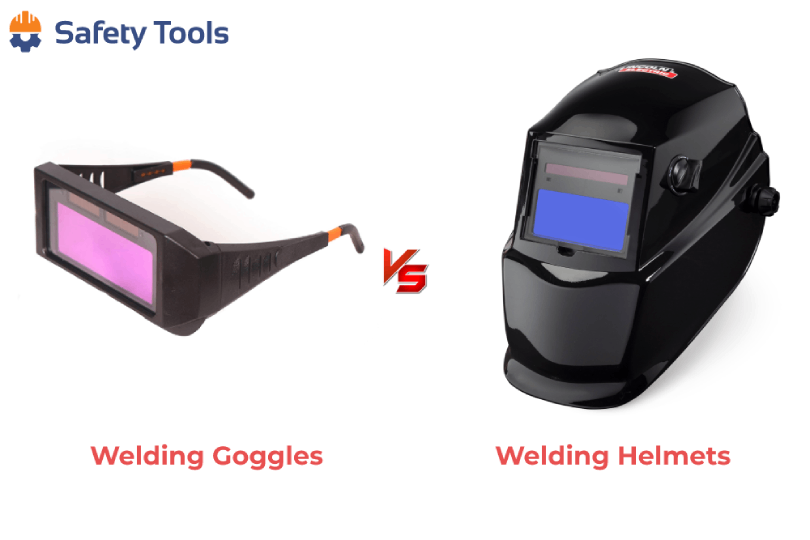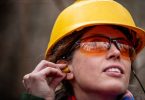Safety is of utmost concern for any welder. Since welding helmets cover your whole face and neck while goggles protect only your eyes, there’s no doubt that helmets should be in your consideration.
Still many prefer welding goggles for their convenience and cool look! Are you one of them?
If yes, any seasoned welder would ask you to change your mind right now! The cost of switching from helmets to goggles just for discomfort will come at a high price –
Welding Goggles vs Helmets: How They Differ
Protection
Goggles
Welding goggles vary based on lens filters that are designed to absorb UV rays. Some are able to protect from specific types of UV rays, which means you need to find the right type as per your welding process.
Your goggles should fit snugly and cover from the eyebrows to the cheekbone. Goggles that have side shields or wrap-around frames are safer since sparks and debris can come from any direction.
But since they protect your eyes only, they leave the rest of the face unprotected and exposed to radiation and heat. In the long run, this may cause symptoms that look like sunburn and in the worst-case scenario, skin cancer.
Helmets
Helmets obviously have a better protection level than goggles that shield your entire face and neck from harsh UV light, heat, sparks, optical radiation, dirt, and debris. The intense light of the welding arc can cause flash burns to your face or photokeratitis – a severe and painful eye condition that you don’t want to have.
Check if your helmet meets ANSI standards to safeguard from the harmful fumes and gases. Any ANSI standard helmet will protect your eyes effectively despite the shade number.
Convenience
Goggles
Despite the safety issues, many welders prefer welding goggles just because they are stylish and lightweight. After all, welding goggles provide you the freedom to move your head in any direction you like without limiting your visibility.
However, this freedom comes at the cost of exposing the rest of your face to the extreme level of UV light, radiation, and heat.
Helmets
You may experience fatigue if you wear your welding helmet for a long time since they are heavy and bulky. Moreover, they can be suffocating and confining in some cases.
Visibility
Goggles
The lenses of welding goggles are clear enough despite having filters that protect the eyes from the intense UV rays.
As a result, you can clearly see the outcomes of your work while protecting your eyes to some extent. Even those who wear glasses can use goggles without any visibility issue.
Lighter shades have better visibility than darker shades and choosing the right shade will depend on your welding applications.
Helmets
Both the standard and passive welding helmets have a fixed shade number that ranges from 2-14. For instance, shade numbers 3 to 8 are for gas welding or plasma and torch cutting (we will talk more about shade numbers later).
On the other hand, auto darkening helmets have better visibility as they can automatically shift to darker shade if the light exceeds a certain level, and vice-versa.
Also, welding helmets provide a limited field of view compared to welding goggles.
Maintenance
Goggles
Welding goggles require little or no maintenance. All you’ve to do is rub the inside and outside of the pair with a piece of soft and clean cloth moistened with a commercial disinfectant or soap and then dry it.
Helmets
When you use your welding helmet regularly, you expose it to welding debris, smoke, dirt, and fumes. This may obstruct your visibility and you need to take good care of it for increased safety, productivity, and lifespan.
The lens of a helmet is most likely the dirtiest part because all types of welding debris settle on it easily. The lens should be cleaned immediately if you notice any dark spots on it.
Just take out the lens carefully and then wipe it with a soft piece of cloth or a soft brush to remove the dirt. You can use a special lens solution to get rid of the dust spots that won’t easily go away.
After that, clean the rest of the helmet with a soft-bristled brush, air pressure duster, and a helmet cleaner.
Disinfect the entire welding hood with a cleaner spray to get rid of all the germs and viruses and then dry it for next use.
Advantages and Disadvantages of Welding Goggles and Helmet
Welding Goggles
Pros
- Less bulky
- Lightweight and convenient
- Won’t limit visibility
- Wider field of view
Cons
- Full face not protected
- Except eyes, the rest of the face is exposed to heat, UV, and IR that may cause serious diseases
Helmet
Pros
- Lens with infrared (IR) and ultraviolet (UV) coating
- Protects the entire face
- Protects the neck
- Best for arc welding
- Some have advanced auto-darkening features
- Electronic filters instantly lighten or darken the shade
Cons
- Bulky and less convenient to use
- Confining and suffocating
- Auto darkening helmets are expensive
- Replacement parts are expensive
Required Shade Numbers for Protection in Different Welding Operations
The shade of lens for appropriate protection depends on the current rating of the welding situation. The OSHA and ANSI recommended DIN shade numbers for some welding operations are charted below:
| Operations | Weld Current Range | OSHA Minimum Shade number | ANSI recommendations |
|
Shielded Metal Arc Welding |
Less than 60 | 7 | 7 |
| 60-160 | 8 | 10 | |
| 160-250 | 10 | 12 | |
| 250-550 | 11 | 14 | |
| Gas Welding | Plate thickness under 3.2mm -over 150mm | 4-6 | 5-8 |
| Gas Metal Arc Welding | Less than 60 – more than 500 | 7-10 | 11-14 |
| Plasma Arc Welding | Less than 20 – more than 800 | 6-11 | 6-14 |
| Plasma Arc Cutting | Less than 400 – more than 800 | 8-10 | 9-14 |
| Air Carbon Arc Cutting | Less than 500 – more than 1000 | 10-11 | 12-14 |
| Oxygen Cutting | Plate thickness under 25mm – over 150 mm | 3-5 | 4-6 |
Welding Goggles vs Helmets: Which One Is Better?
Welding goggles are lightweight and comfortable, but they protect only your eyes and leave the rest of the face exposed to heat, weld spatter, ultraviolet light and other particles and debris.
On the other hand, welding helmets are heavy, bulky and uncomfortable but they protect the welder’s entire face and neck against UV rays, flash burn, heat, and sparks.
For safety concerns, welding helmets are the ultimate choice. If you have the budget, go for an auto-darkening helmet because it will save you from accidental flashes that you may often face with regular welding helmets as you have to lift your hood up and down constantly.
FAQs
1. Do welders go blind over time?
Ans: Welders are more vulnerable to eye injuries but going blind over time can be avoided using proper safety gear like welding helmets and goggles.
2. Can I wear glasses under a welding helmet?
Ans: Wearing glasses under a welding helmet is possible but that can be uncomfortable. The ideal solution is to insert the bifocal lenses into the helmet to have clear vision and a magnified view.
3. What are the dangers of welding without welding goggles?
Ans: If you use shaded lenses with lower number than necessary, or no lens at all, your eyes will face permanent loss of vision due to the UV rays, IR, heat, and other flying debris produced while welding.









Leave a Comment